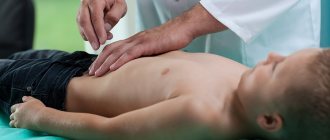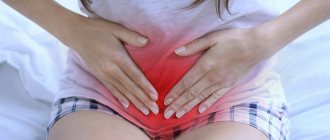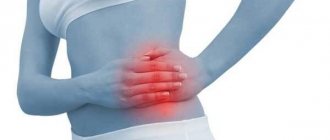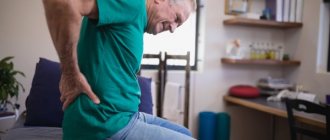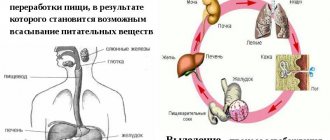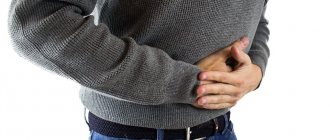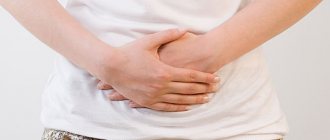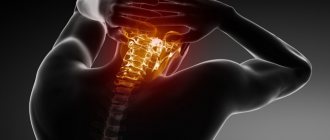Pain in the navel area when pressed can be of different types. It can be aching, sharp, dull or sudden. Just like the pain itself, the causes of its occurrence can be varied.
Pain in the navel area may be accompanied by the following diseases:
- intestinal colic;
- umbilical hernia;
- intervertebral hernia;
- stones coming out;
- appendicitis;
- gynecology.
Intestinal colic
When the stomach hurts in the navel area, pain due to intestinal colic is caused by a spasm of the small or large intestine. It may be caused by diarrhea or constipation. Also, do not forget about dysbiosis and digestive disorders. Pain in this case occurs as a result of compression of the intestinal muscles. The stronger the pain, the stronger the muscle compression. Intestinal colic in newborns is common.
It is impossible to name any universal methods for treating such a phenomenon as intestinal colic. To get rid of pain, you can use medication. If intestinal colic is caused by constipation or a disturbance in the exhaust of gases, then some relaxing medications should be rationally used. After the pain has subsided, you will need to seek help from a doctor.
Stomach hurts when pressing below the navel
During a medical examination, the doctor checks how the abdomen feels to the touch, where discomfort occurs during palpation, that is, when pressing on the abdomen, palpating. This is done to identify the clinical sign - pain. If the patient himself feels the pain, the pain is detected by the doctor: the patient may not know what exactly he will feel when pressing on a certain area.
The article will tell you about the causes of pain identified during self-examination by pressing on the front wall of the abdomen.
Umbilical hernia
Pain in the navel area when pressed may be caused by an umbilical hernia. Pain is present around the navel. Very often this disease is observed in children. In this case, the child begins to cry very much and presses his legs to his tummy. The pain is very acute, since the hernia puts pressure on the stomach and when food enters it, pressure occurs on the umbilical hernia. To determine an umbilical hernia in babies, you need to undergo a course of examination. In some cases, an umbilical hernia may be visible on the surface of the tummy - the navel protrudes to a large extent. An umbilical hernia in a child can close before he reaches 12 years of age, that is, in some cases it does not require surgical intervention.
Also, after a difficult birth, women may experience an umbilical hernia. All this happens for the reason that the woman in labor has very weak abdominal muscles, and with excessive tension, a hernia can very easily appear.
The symptoms of this disease directly depend on the size of the hernia. Obesity can also cause an umbilical hernia. In some cases, the hernia may be represented by a fatty omentum, but there will be no pain or signs of the presence of this type of hernia.
Burning sensation in women
If a woman has a burning sensation below the navel, she must first make sure that she is pregnant or not. The numerous physiological changes that occur in the body during this crucial period can cause various symptoms. These include a burning sensation around the navel, itching of the abdomen, and the appearance of pain in the area of the ovaries. It cannot be said that these signs are dangerous to health. But you should notify your gynecologist about their presence.
If pregnancy is not confirmed, and a burning sensation in the navel area persists, it is necessary to undergo examination to identify the following ailments:
- Appendicitis.
- Ulcerative colitis.
- Cystitis and other diseases of the genitourinary system.
- Ectopic pregnancy.
- Skin diseases.
Intervertebral hernia
An intervertebral hernia that occurs in the lumbar region can cause quite severe pain in the navel area. The nerve endings of the spine are located too close to the digestive tract. During the transmission of impulses, pain will appear, which is aching in nature and occurs when a person has been sitting or walking for too long. Since the hernia is located between the vertebrae, friction between them can create such transmitted impulses.
Passing stones from the kidneys or gall bladder
The body’s ability to remove stones from any organ independently or using various methods can also cause pain. The pain when stones pass is long-lasting and accompanies a person until the stone is completely released through the genitourinary system. As a rule, severe pain accompanies the passage of large stones, the size of which can reach 8 mm. Gallstones may require surgery.
If the stone comes out of the left kidney, then pain will appear in the navel area on the left. If the stone comes out of the right kidney, there will be pain in the navel area on the right. All this is due to the fact that the stone, during its release, irritates the walls of the ureters and creates an uncomfortable state for the person. In this case, it is possible to reduce the pain threshold with the help of medications, but very rarely.
Pain to the left of the navel
If pain develops in the left side at the level of the navel, you need to determine which organ is located on the lower left. On the left are the omentum, intestinal loops, ureter, and renal hilum.
Pain in this area may be due to gas accumulation. If a pathological process of the large intestine develops, then in addition to pain, stool disturbances, the appearance of mucus and blood in the stool, and an increase in temperature will be noted.
If scarlet blood appears in the stool. This means that a patient with hemorrhoids, if the stool becomes tarry, this means that bleeding is developing in the gastrointestinal tract.
Pain in the umbilical area due to irritation of the diaphragm is also possible with viral lung diseases.
Appendicitis
This disease occurs completely suddenly. It is impossible to prepare for its appearance. Appendicitis is considered the cleansing organ of the human body. In simple words: appendicitis is a container in which various harmful substances for the body accumulate. After such a peculiar container is already overfilled, a displacement of all the organs of the digestive tract occurs. In this case, the pain in the navel area when pressed will be acute.
The main signs of appendicitis are high fever, nausea, and vomiting. Sometimes diarrhea or constipation occurs. It all depends on the body. The most important thing is to call an ambulance in time. If this is not done, appendicitis may rupture, and then a series of operations will have to be performed to cleanse the organs of toxins that are located close to this organ.
The importance of making a correct diagnosis for pain in the navel area
Any acute pain requires urgent diagnosis, as the cause may be serious and require urgent treatment. If a person suffers from chronic diseases, periodic exacerbations are possible. In any case, the patient needs to know what is happening inside the body in order to respond correctly to pain.
Oncological diseases begin with a small tumor that can be overlooked, after which it will metastasize and it will be very difficult to cure a person. Therefore, it is recommended to undergo a full examination.
It is important not only to make a correct diagnosis, but also to provide timely assistance. Some symptoms indicate acute intoxication, in which decisions must be made quickly.
Gynecology
No matter how paradoxical it may sound, pain in the navel area can be caused by acute diseases of the reproductive system. As a rule, women are susceptible to such diseases. The ovaries play the main role in the occurrence of such pain. If a cyst forms on one of them or has already formed, then over time it will break through. The fluid from this formation enters the intestines. Because of this, cramps begin throughout almost the entire abdominal area. Diarrhea may occur. The temperature rises only at an advanced stage of the disease.
In this case, you will need to call an ambulance. Only after a thorough examination will it be possible to determine the reason for the pain in the navel area.
Other causes of burning in the abdomen
Stomach pain may be due to:
- nervous tension;
- helminthic infestation;
- increased sensitivity of the esophagus;
- aneurysm;
- gastroparesis.
Chronic stress negatively affects the internal systems of the body. It can reduce or stop the functioning of the stomach during the period of burning in the abdomen. It ceases to perform its usual functions, and food processing is suspended. For this reason, appetite decreases sharply, and the patient does not feel a bout of hunger for a long time. Against the background of this condition, there is a decrease in body weight and a burning sensation in the abdomen. With such an illness, the patient needs competent therapy. It is impossible to cure the disease of nervous overstrain on your own.
At the age of 50, men undergo a change in the structure of their internal organs. At this age, there is a risk of rupture of the inner wall of the aorta. A person with an aneurysm feels a strong burning sensation in the abdomen, with a burning pain radiating to the lumbar region.
https://youtu.be/kBNo6GhvPiI
With an unbalanced diet, increased sensitivity of the esophagus occurs. Eating hot or cold food and snacks lead to discomfort in the gastrodigestive tract. Along with a burning sensation in the stomach, an unpleasant taste appears in the mouth, which is accompanied by an unpleasant odor.
Treatment of pain in the navel area
A process such as pain must be approached quite responsibly. You need to go through a number of procedures:
- take a blood test for the presence of inflammatory processes;
- do an ultrasound of the abdominal cavity;
- x-ray (alternative to ultrasound);
- take a urine test.
All such tests are capable of identifying inflammatory processes in the body and in which organ they occur.
Treatment methods depend directly on the definition of the disease. It cannot be said that there are universal methods that can relieve pain in the navel area. You can take painkillers, but their effect will be temporary. It is best to see a doctor for an examination. If the pain appears suddenly, it is best to call an ambulance, which will take the patient to the clinic for treatment.
Localization and nature of pain
Any of the diseases in which it is painful to press the navel creates a specific clinical picture and is expressed by characteristic pain:
- Aching. Characteristic of intestinal obstruction, excessive gas formation, chronic enteritis, the formation of nodules, adhesions, and tumor formations. Possible manifestations during pregnancy, stretching of the abdominal walls and ailments of the reproductive and urinary systems.
- Spicy. It may indicate ulcerative lesions or cholecystitis, as well as hernial strangulation. Sharp pain in the umbilical zone, which radiates to the lumbar region when relieving minor needs, indicates the movement of stones in the kidneys and gall bladder.
- Pulling. It appears during pregnancy, diseases of the urinary system, prostatitis in men, distension of the abdominal walls, and intestinal obstruction.
- Stabbing or cutting. Characteristic of cholecystitis, appendicitis. Injection near the navel can occur in case of any disturbances in the organs of the gastrointestinal tract.
Volvulus, umbilical hernia, oncology, appendicitis, abdominal migraine provoke especially severe painful sensations.
The location of pain when pressing on the navel will help identify the suspected disease by the area where the pain is most severe:
| Location of pain | Possible illness |
| Around the navel | Inflammation of the appendix, umbilical hernia. |
| On the left with irradiation to the left side | Rupture of the follicle or stone exit from the corresponding side, diseases of the spleen, sigmoiditis. |
| Right with kickback to the right side | Volvulus, appendicitis, liver and gallbladder diseases, rupture of the follicle or stone passage from the corresponding side, pyelonephritis, inflammation in the colon, gastroduodenitis. |
| Above the navel | Ulcerative lesions of the stomach and duodenum, gastritis. |
| Below the navel | Nonspecific ulcerative colitis, mesadenitis, enteritis, Crohn's disease, inflammatory processes in the small and large intestines, abnormalities in the genitourinary system. In the latter case, the pain often manifests itself low, in the groin area. |
Pain syndrome high above the navel is most often caused by stomach and intestinal ailments. Painful sensations below the navel appear mainly due to disorders in the rectum. In addition, the manifestation of unpleasant feelings of this kind often indicates ailments of the reproductive system.
